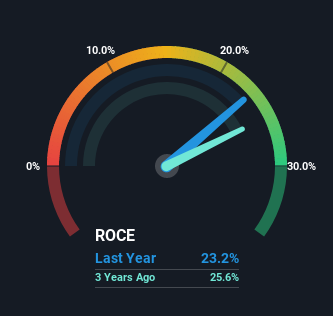
Did you know there are some financial metrics that can provide clues of a potential multi-bagger? Typically, we'll want to notice a trend of growing return on capital employed (ROCE) and alongside that, an expanding base of capital employed. Ultimately, this demonstrates that it's a business that is reinvesting profits at increasing rates of return. Ergo, when we looked at the ROCE trends at Polycab India (NSE:POLYCAB), we liked what we saw.
What Is Return On Capital Employed (ROCE)?
For those who don't know, ROCE is a measure of a company's yearly pre-tax profit (its return), relative to the capital employed in the business. The formula for this calculation on Polycab India is:
Return on Capital Employed = Earnings Before Interest and Tax (EBIT) ÷ (Total Assets - Current Liabilities)
0.23 = ₹14b ÷ (₹81b - ₹21b) (Based on the trailing twelve months to September 2022).
Thus, Polycab India has an ROCE of 23%. In absolute terms that's a great return and it's even better than the Electrical industry average of 14%.
Check out our latest analysis for Polycab India

Above you can see how the current ROCE for Polycab India compares to its prior returns on capital, but there's only so much you can tell from the past. If you're interested, you can view the analysts predictions in our free report on analyst forecasts for the company.
What Can We Tell From Polycab India's ROCE Trend?
Polycab India deserves to be commended in regards to it's returns. Over the past five years, ROCE has remained relatively flat at around 23% and the business has deployed 146% more capital into its operations. Now considering ROCE is an attractive 23%, this combination is actually pretty appealing because it means the business can consistently put money to work and generate these high returns. If Polycab India can keep this up, we'd be very optimistic about its future.
On a side note, Polycab India has done well to reduce current liabilities to 26% of total assets over the last five years. Effectively suppliers now fund less of the business, which can lower some elements of risk.
The Key Takeaway
In summary, we're delighted to see that Polycab India has been compounding returns by reinvesting at consistently high rates of return, as these are common traits of a multi-bagger. And the stock has done incredibly well with a 153% return over the last three years, so long term investors are no doubt ecstatic with that result. So while the positive underlying trends may be accounted for by investors, we still think this stock is worth looking into further.
If you want to continue researching Polycab India, you might be interested to know about the 1 warning sign that our analysis has discovered.
High returns are a key ingredient to strong performance, so check out our free list ofstocks earning high returns on equity with solid balance sheets.
New: Manage All Your Stock Portfolios in One Place
We've created the ultimate portfolio companion for stock investors, and it's free.
• Connect an unlimited number of Portfolios and see your total in one currency
• Be alerted to new Warning Signs or Risks via email or mobile
• Track the Fair Value of your stocks
Have feedback on this article? Concerned about the content? Get in touch with us directly. Alternatively, email editorial-team (at) simplywallst.com.
This article by Simply Wall St is general in nature. We provide commentary based on historical data and analyst forecasts only using an unbiased methodology and our articles are not intended to be financial advice. It does not constitute a recommendation to buy or sell any stock, and does not take account of your objectives, or your financial situation. We aim to bring you long-term focused analysis driven by fundamental data. Note that our analysis may not factor in the latest price-sensitive company announcements or qualitative material. Simply Wall St has no position in any stocks mentioned.
About NSEI:POLYCAB
Polycab India
Manufactures and sells wires and cables under the POLYCAB brand in India and internationally.
Flawless balance sheet with limited growth.


